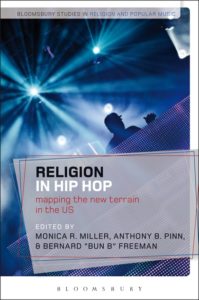
Religion in Hip-Hop: Mapping the New Terrain in the US
Monica Miller, Anthony B. Pinn, Bernard “Bun B” Freeman, eds. Religion in Hip-Hop: Mapping the New Terrain in the US. London: Bloomsbury Publishing, 2015. pp. 296 $34.95 (paperback).
Reviewed by Gregory Rapier
Consisting of fourteen original pieces by as many authors, Religion in Hip-Hop offers a variety of voices with varying critical lenses the opportunity to examine the nuanced relationship between hip-hop and religion. The resulting work reads more like a cipher than one succinct argument, with authors conversing with one another, bouncing off of each-others work, and riding over the same beats from opposite angles to radically different conclusions. The result is a battleground where the very souls of hip-hop’s greatest appear to be on the line. Is Tupac a modern day Christian prophet? A priest for the marginalized? Or is he more nihilistic? You will find arguments for all three here.
While the collection begins in a relatively straightforward manner examining various artists’ faith by delving into their art and lives, later chapters quickly move into more dynamic territory. Editors Monica Miller and Anthony B. Pinn describe the volume as holding “Tupac alongside Adorno, [Lupe] Fiasco . . . in balance with Marx, rappers’ oratorical skills with preachers, Kanye West with Nietzche . . . Marcy Projects paralleled with esteemed art galleries . . . West and Derrida over and against performance artists like Marina Abramovic” while also examining hip-hop’s “engagement with . . . conspiracy theories, the new humanism in hip-hop that challenges and rejects fundamentalisms” and hip-hop’s tenuous relationship with the church (216-217).
The importance of rapper Bernard “Bun B” Freeman’s involvement cannot be overstated: while most of the essays are at home in abstract theory, Bun B’s contributions remain decidedly and refreshingly in the here and now. His first piece rejects the common notion of hip-hop and religion as diametrically opposed, instead describing the two as parallel paths. Other standout contributions include those of Elonda Clay, Daniel White-Hodge, Greg Dimitriadis, and Joseph Winters.
Those hoping to be spiritually fed may wish to look elsewhere, as the essays generally define religion and God as loose concepts, thus refraining from pushing any particular religious agenda. While the authors are undoubtedly experts in this field, the overall selection of rappers for in-depth exploration is surprisingly narrow. With some overlap, four of the fourteen chapters study Jay-Z, with both Kanye and Tupac being discussed at length in three chapters each. This feels like a missed opportunity, for this collection successfully breaks new ground academically but recycles the same three figures time and time again. The newer generation of rappers is particularly under-represented, with figures such as Jay Electronica, Tyler the Creator, and Kendrick Lamar—each of whom possess a catalog of music with distinct religiosity—being omitted entirely. This is but a minor complaint in a great series of essays destined to advance and expand the field of hip-hop and religion. This collection belongs on the shelves of hip-hop heads and religious scholars alike.
Gregory Rapier, MDiv Student, Princeton Theological Seminary
